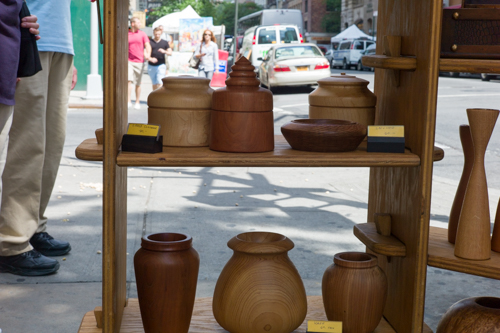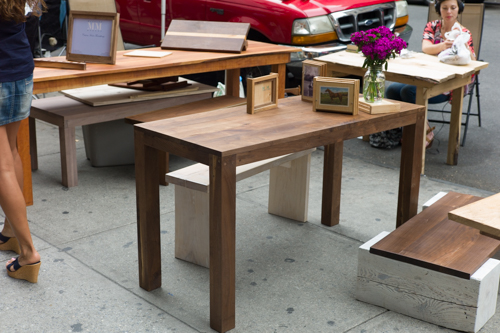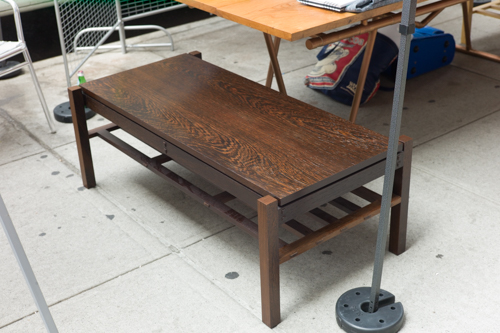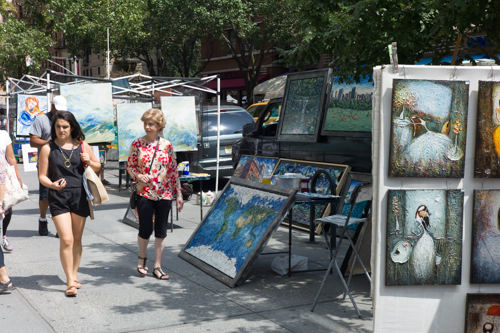|
|
09/03/2014 |
 Every year since 1931 the streets of Washington Square Park are filled with booth after booth of artist and craftspeople exhibiting their work. The "Washington Square Outdoor Art Exhibit" took place this year last weekend and will reprise next weekend (Sept 6-7, 2014). The works range from big paintings for several thousands of dollars to small work in the tens and hundreds. Some of it I would love to hang in my living room, some you would have to pay me to hide in a closet. Unlike the rarefied world of galleries in Chelsea and Soho the art here is more approachable. The artists range from working artists to weekend warriors, all excited by the idea that over the days of the show thousands of people will walk by and some might stop and like their stuff. It's a great way to find decorations for your house. In addition to the many artists and sculptors there were many jewelery makers, fabric arts people, and yes, a few woodworkers. Three that I found, each were looking for a different type of customer, and each had their own slant on how to approach their audience. Every year since 1931 the streets of Washington Square Park are filled with booth after booth of artist and craftspeople exhibiting their work. The "Washington Square Outdoor Art Exhibit" took place this year last weekend and will reprise next weekend (Sept 6-7, 2014). The works range from big paintings for several thousands of dollars to small work in the tens and hundreds. Some of it I would love to hang in my living room, some you would have to pay me to hide in a closet. Unlike the rarefied world of galleries in Chelsea and Soho the art here is more approachable. The artists range from working artists to weekend warriors, all excited by the idea that over the days of the show thousands of people will walk by and some might stop and like their stuff. It's a great way to find decorations for your house. In addition to the many artists and sculptors there were many jewelery makers, fabric arts people, and yes, a few woodworkers. Three that I found, each were looking for a different type of customer, and each had their own slant on how to approach their audience.
Michael Manus is a woodturner who has exhibited at the show for over 20 years. This year he won first prize in the "Crafts Wood" category with a turned piece "Hollow form with finial". When younger he used to exhibit at many shows. Now, in semi-retirement, this is the only show he does. His work is mainstream turned wooden-ware. Well executed, mid-priced pieces from around $40 and up, most of his pieces are designed to be functional in the house. He told me that he's always done well at the show and certainly part of the reason for his success is that his work is priced for the impulse purchaser and can easily be carried away.
 Santino Alvarez, furniture maker was exhibiting for the second year. I had a very pleasant talk with Santino and his wife. If I had to characterize his style it would be a very interesting take on modern rectilinear forms, with an organic feel. His work is all custom and the larger table in the photo starts at just under $1000. I asked about how business was because with furniture purchases, even a several hundred dollar purchase isn't really impulsive. Santino said that last year (their first at the show) they sold very little at the actual show, but there were many follow-up commissions which made the show for him a rousing success. Santino Alvarez, furniture maker was exhibiting for the second year. I had a very pleasant talk with Santino and his wife. If I had to characterize his style it would be a very interesting take on modern rectilinear forms, with an organic feel. His work is all custom and the larger table in the photo starts at just under $1000. I asked about how business was because with furniture purchases, even a several hundred dollar purchase isn't really impulsive. Santino said that last year (their first at the show) they sold very little at the actual show, but there were many follow-up commissions which made the show for him a rousing success.
 Peter A. Allen is a primarily architectural woodworker hailing from New Bedford, MA. (the exhibitors come from all over) and decided to show some of his original furniture designs at the show. The table, of wide English Brown Elm boards, is on a base of buffed copper pipe. The use of copper really sets off wood and both the brown elm and the copper accent each other without either overcoming the piece. While obviously Peter can use this theme for any custom situation, this particular table is $4200. The smaller solid Wenge coffee tables are 1800. Peter A. Allen is a primarily architectural woodworker hailing from New Bedford, MA. (the exhibitors come from all over) and decided to show some of his original furniture designs at the show. The table, of wide English Brown Elm boards, is on a base of buffed copper pipe. The use of copper really sets off wood and both the brown elm and the copper accent each other without either overcoming the piece. While obviously Peter can use this theme for any custom situation, this particular table is $4200. The smaller solid Wenge coffee tables are 1800.
A city street isn't the most effective means of showing off someone's work so click on the maker's names to check out their websites. (Michael Manus does not have a website).
 These were all the woodworkers I saw. Each working in their own milieu, and their own economic model. The problem of course with woodworking as a craft fair product, and the reason for so few woodworker's exhibiting, is that almost any furniture or wooden object is too expensive for an impulse purchase and most custom furniture is out of the average budget. More significant I think is, that in general, as a society we don't understand the idea of what custom furniture can do for you, and understand its value, like we do with clothing and jewelery. This is what I feel is so important about these furniture makers with the courage to exhibit. It turns out to be profitable for them, which makes it sustainable, but they are doing a great job of planting the idea in people walking by that they can get something special, made by a person, not a factory. The show eases people in. How many people bought their first piece of custom furniture only after getting used to the idea of wood as craft by impulsively buying a turned bowl? More than a few. How many people, who would never consider getting anything made for them, start talking about "maybe we should get a proper table for the dining alcove that actually fits?" More than a few. It takes time and many shows. I hope for some viewers, after seeing this exhibit, commissioning some furniture maker somewhere is an idea a little less far fetched. For me the entire show, with it's tens of thousands of visitors walking by, is on the front line of making people aware that not everything they buy needs to come from a factory in a far-away land paying starvation wages and you can get nice stuff made just for you. These were all the woodworkers I saw. Each working in their own milieu, and their own economic model. The problem of course with woodworking as a craft fair product, and the reason for so few woodworker's exhibiting, is that almost any furniture or wooden object is too expensive for an impulse purchase and most custom furniture is out of the average budget. More significant I think is, that in general, as a society we don't understand the idea of what custom furniture can do for you, and understand its value, like we do with clothing and jewelery. This is what I feel is so important about these furniture makers with the courage to exhibit. It turns out to be profitable for them, which makes it sustainable, but they are doing a great job of planting the idea in people walking by that they can get something special, made by a person, not a factory. The show eases people in. How many people bought their first piece of custom furniture only after getting used to the idea of wood as craft by impulsively buying a turned bowl? More than a few. How many people, who would never consider getting anything made for them, start talking about "maybe we should get a proper table for the dining alcove that actually fits?" More than a few. It takes time and many shows. I hope for some viewers, after seeing this exhibit, commissioning some furniture maker somewhere is an idea a little less far fetched. For me the entire show, with it's tens of thousands of visitors walking by, is on the front line of making people aware that not everything they buy needs to come from a factory in a far-away land paying starvation wages and you can get nice stuff made just for you.
 N.B. If you wandered past the first exhibitors in the 1931 show you could have picked up a Jackson Pollard or Willem DeKooning for not a lot of money as both according to the exhibition brochure were not yet famous and needed rent money. N.B. If you wandered past the first exhibitors in the 1931 show you could have picked up a Jackson Pollard or Willem DeKooning for not a lot of money as both according to the exhibition brochure were not yet famous and needed rent money.
Maker Faire is in a few weeks. I'll be giving a presentation called: How One Small Company is Using Maker Technology to Stay Competitive in an Old World Industry. I'll write more about what I will be talking about next week, but I would love to see you come and say hi to me. We might even have some prototypes of new stuff we are working on. |
Join the conversation |
|
 Joel's Blog
Joel's Blog Built-It Blog
Built-It Blog Video Roundup
Video Roundup Classes & Events
Classes & Events Work Magazine
Work Magazine


 Every year since 1931 the streets of Washington Square Park are filled with booth after booth of artist and craftspeople exhibiting their work. The "Washington Square Outdoor Art Exhibit" took place this year last weekend and will reprise next weekend (Sept 6-7, 2014). The works range from big paintings for several thousands of dollars to small work in the tens and hundreds. Some of it I would love to hang in my living room, some you would have to pay me to hide in a closet. Unlike the rarefied world of galleries in Chelsea and Soho the art here is more approachable. The artists range from working artists to weekend warriors, all excited by the idea that over the days of the show thousands of people will walk by and some might stop and like their stuff. It's a great way to find decorations for your house. In addition to the many artists and sculptors there were many jewelery makers, fabric arts people, and yes, a few woodworkers. Three that I found, each were looking for a different type of customer, and each had their own slant on how to approach their audience.
Every year since 1931 the streets of Washington Square Park are filled with booth after booth of artist and craftspeople exhibiting their work. The "Washington Square Outdoor Art Exhibit" took place this year last weekend and will reprise next weekend (Sept 6-7, 2014). The works range from big paintings for several thousands of dollars to small work in the tens and hundreds. Some of it I would love to hang in my living room, some you would have to pay me to hide in a closet. Unlike the rarefied world of galleries in Chelsea and Soho the art here is more approachable. The artists range from working artists to weekend warriors, all excited by the idea that over the days of the show thousands of people will walk by and some might stop and like their stuff. It's a great way to find decorations for your house. In addition to the many artists and sculptors there were many jewelery makers, fabric arts people, and yes, a few woodworkers. Three that I found, each were looking for a different type of customer, and each had their own slant on how to approach their audience. 

 These were all the woodworkers I saw. Each working in their own milieu, and their own economic model. The problem of course with woodworking as a craft fair product, and the reason for so few woodworker's exhibiting, is that almost any furniture or wooden object is too expensive for an impulse purchase and most custom furniture is out of the average budget. More significant I think is, that in general, as a society we don't understand the idea of what custom furniture can do for you, and understand its value, like we do with clothing and jewelery. This is what I feel is so important about these furniture makers with the courage to exhibit. It turns out to be profitable for them, which makes it sustainable, but they are doing a great job of planting the idea in people walking by that they can get something special, made by a person, not a factory. The show eases people in. How many people bought their first piece of custom furniture only after getting used to the idea of wood as craft by impulsively buying a turned bowl? More than a few. How many people, who would never consider getting anything made for them, start talking about "maybe we should get a proper table for the dining alcove that actually fits?" More than a few. It takes time and many shows. I hope for some viewers, after seeing this exhibit, commissioning some furniture maker somewhere is an idea a little less far fetched. For me the entire show, with it's tens of thousands of visitors walking by, is on the front line of making people aware that not everything they buy needs to come from a factory in a far-away land paying starvation wages and you can get nice stuff made just for you.
These were all the woodworkers I saw. Each working in their own milieu, and their own economic model. The problem of course with woodworking as a craft fair product, and the reason for so few woodworker's exhibiting, is that almost any furniture or wooden object is too expensive for an impulse purchase and most custom furniture is out of the average budget. More significant I think is, that in general, as a society we don't understand the idea of what custom furniture can do for you, and understand its value, like we do with clothing and jewelery. This is what I feel is so important about these furniture makers with the courage to exhibit. It turns out to be profitable for them, which makes it sustainable, but they are doing a great job of planting the idea in people walking by that they can get something special, made by a person, not a factory. The show eases people in. How many people bought their first piece of custom furniture only after getting used to the idea of wood as craft by impulsively buying a turned bowl? More than a few. How many people, who would never consider getting anything made for them, start talking about "maybe we should get a proper table for the dining alcove that actually fits?" More than a few. It takes time and many shows. I hope for some viewers, after seeing this exhibit, commissioning some furniture maker somewhere is an idea a little less far fetched. For me the entire show, with it's tens of thousands of visitors walking by, is on the front line of making people aware that not everything they buy needs to come from a factory in a far-away land paying starvation wages and you can get nice stuff made just for you.  N.B. If you wandered past the first exhibitors in the 1931 show you could have picked up a Jackson Pollard or Willem DeKooning for not a lot of money as both according to the exhibition brochure were not yet famous and needed rent money.
N.B. If you wandered past the first exhibitors in the 1931 show you could have picked up a Jackson Pollard or Willem DeKooning for not a lot of money as both according to the exhibition brochure were not yet famous and needed rent money.